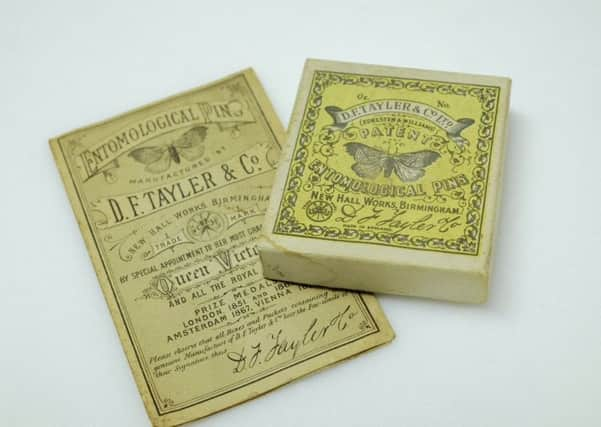Exhibit of the Week: Entomological pins


Those are the pins which are used to display insects in collections or a museum setting. What differentiates them from everyday dressmaking pins can be various – their material (some are black enamel, to withstand the bodily fluids of the insects); their length and/or thickness; and the fact that some are headless, to give a neat finish to a display or for exceptionally tiny insects.
Our picture today shows packaging for Victorian pins, but the product (and often the packaging, too) seems to differ very little today.
Advertisement
Hide AdAdvertisement
Hide AdOur pins were manufactured by DF Tayler & Co Ltd of New Hall Works in Birmingham. Founded in 1787, the company seems to have been a real child of the industrial revolution, and something of a bellwether of the health of the British manufacturing industry.
By 1880, it boasted automatic machines which could produce up to 200,000 pins a day. Just 12 years later, at the turn of the century, it had no less than 60 of these machines making 12 million pins a day.
These weren’t, of course, all entomological pins – the demand for those must surely have been relatively small. DF Tayler also produced dressmaking pins, hair pins and other small metal and wire objects – and at some point in the second half of the 19th century, it incorporated another company, Edelsten and Williams, which was listed as ‘hook and eye makers’ and ‘needle and fish hook manufacturers’.
By 1914, DF Tayler was describing itself as a manufacturer of pin, metal and wire, specialising in pins, hair pins, safety pins, hooks and eyes, fasteners and ‘novelties of all kinds in pins’. It also listed itself as a printers, and had 500 employees.
Advertisement
Hide AdAdvertisement
Hide AdJust after World War II, its product list had expanded to include ‘pins of all kinds including: domestic, entomological, perforating, brush, laundry, London brand, knitting, etc, needles; crochet hooks, safety pins, gramophone needles and general metal smallwares’.
By 1961, and now with a workforce down to 350, the company was making ‘non-ferrous strip, brass and steel wire, pins and needles’.
And at some point since then, which we have been unable to (sorry!) pin down, DF Tayler & Co was dissolved.
The packaging we show here today, though, was from a company very much on the way up. It boasts of being ‘by special appointment to Her Most Gracious Majesty Queen Victoria and all the royal family’, and lists its prize medals: London 1851 and 1862, Amsterdam 1867, Vienna 1873.
Advertisement
Hide AdAdvertisement
Hide AdPrices per ounce for silvered pins are given – six pence for [presumably size] 11, one shilling for size 16, two shillings for size two, and so on. ‘If Gilt’, we are told, the pins were one shilling per ounce extra. Postage, of course, was extra – a further penny for a quarter or half ounce of pins, one-and-a-half pennies for an ounce (we are assured, though, that ‘the Pins are securely packed in Boxes, to prevent damage in transit’).
Now, remember that we’re talking in ‘old’ (pre-decimalisation) money here, so it’s difficult to make a direct comparison – but a shilling was 12 old pence, and there were 20 of them to a pound. In the late 1800s, a general office clerk could expect to make around 25 shillings a week, while a laundress might take home two shillings and six pence a day. A manual labourer might expect to pay three to six shillings a week in rent on a single room in a lodging house.
It’s clear that insect collecting – if you wanted all the kit and caboodle – wasn’t a poor man’s game.
The entomological pins are part of the Scarborough Collections, the name given to all the museum objects and artwork acquired by the borough over the years and now in the care of Scarborough Museums Trust.
For further information, please contact Collections Manager Jennifer Dunne on [email protected] or 01723 384510.